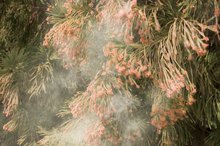Signs and Symptoms of a Yeast Infection in the Throat
A yeast infection in the throat is a medical condition more commonly referred to as candida esophagitis 124. This type of infection develops when a naturally-occurring yeast called Candida albicans grows uncontrollably in the throat. People who have compromised or weakened immune systems due to disease or disease treatments, such as HIV, leukemia or chemotherapy, are at an increased risk of developing a throat yeast infection, according to MedlinePlus, a publication of the National Institutes of Health. People who develop any of the signs and symptoms of a yeast infection in the throat should consult a physician for further evaluation and care.
If you are experiencing serious medical symptoms, seek emergency treatment immediately.
Sore Throat
People who have this type of a yeast infection can experience sensations of pain while swallowing due to sore throat symptoms, Discovery Health reports 4. Fungal overgrowth in the throat can inflame and irritate this region of the digestive tract, which can cause discomfort. Painful swallowing or sore throat symptoms can contribute to a temporary loss of appetite in certain people.
Difficulty Swallowing
What Causes White Spots in the Throat?
Learn More
Throat inflammation caused by a yeast infection can narrow this passageway, leading to difficulty swallowing 3. Affected people can experience a persistent or recurrent sensation that something is stuck at the back of the throat. Additionally, certain people can experience chest discomfort or unusual pressure in the throat or upper body after eating due to swallowing difficulties, MedlinePlus explains 3.
Oral Yeast Infection
An oral yeast infection, or thrush, can occur in conjunction with a throat yeast infection, according to the University of Maryland Medical Center 1. In fact, a throat yeast infection can develop when high levels of yeast in the mouth, caused by thrush, migrate into the throat. Symptoms of oral thrush include oral discomfort; decreased taste sensation; white, creamy oral lesions along the mouth or tongue; cracked skin at the corners of the mouth; and minor oral bleeding 5. People with an oral or throat yeast infection generally need to take an antifungal medication to eradicate the infection and alleviate uncomfortable signs and symptoms.
Related Articles
References
- MayoClinic.com: Oral Thrush--Symptoms
- Martin Lopez JE. Candidiasis (vulvovaginal. BMJ Clin Evid. 2015 Mar 16;2015:0815
- National Center for Biotechnology Information. Vaginal candidiasis (vulvovaginal candidiasis). Updated February 24, 2019.
- Sobel JD. Patient education: Vaginal yeast infection (beyond the basics). UpToDate, Inc. Updated February 7, 2019.
- Zomorodian K, Kavoosi F, Pishdad GR, et al. Prevalence of oral Candida colonization in patients with diabetes mellitus. J Mycol Med. 2016;26(2):103-110. doi:10.1016/j.mycmed.2015.12.008
- Moshfeghy Z, Tahari S, Janghorban, et al. Association of sexual function and psychological symptoms including depression, anxiety and stress in women with recurrent vulvovaginal candidiasis. J Turk Ger Gynecol Assoc. 2020 Jun; 21(2): 90–96. doi:10.4274/jtgga.galenos.2019.2019.0077
- Brunham RC, Gottlieb SL, Paavonen J. Pelvic inflammatory disease. N Engl J Med. 2015;372(21):2039-48. doi:10.1056/NEJMra1411426
- Zhu Y, Bateman BT, Gray KJ, et al. Oral fluconazole use in the first trimester and risk of congenital malformations: Population based cohort study. BMJ. 2020; 369: m1494.doi:10.1136/bmj.m1494
- Behmanesh F, Pasha H, Sefidgar AA, et al. Antifungal effect of lavender essential oil (Lavandula angustifolia) And clotrimazole on candida albicans: An in vitro study. Scientifica (Cairo). 2015;2015:261397. doi:10.1155/2015/261397
- Mertas A, Garbusinska A, Szliszka, E, et al. The influence of tea tree oil (Melaleuca alternifolia) On fluconazole activity against fluconazole-resistant candida albicans strains. Biomed Res Int. 2015; 2015: 590470. doi:10.1155/2015/590470
- Ferris DG, Nyirjesy P, Sobel JD, et al. Over-the-counter antifungal drug misuse associated with patient-diagnosed vulvovaginal candidiasis. Obstet Gynecol. 2002 Mar;99(3):419-25. doi:10.1016/s0029-7844(01)01759-8
- Department of Health & Human Services. Office on Women's Health. Vaginal yeast infections. Apr 1, 2019.
- Iavazzo C, Gkegkes ID, Zarkada IM, Falagas ME. Boric acid for recurrent vulvovaginal candidiasis: the clinical evidence. J Womens Health (Larchmt). 2011;20(8):1245-55.
- Rane HS, Bernardo SM, Howell AB, et al. Cranberry-derived proanthocyanidins prevent formation of Candida albicans biofilms in artificial urine through biofilm- and adherence-specific mechanisms. J Antimicrob Chemother. 2014 Feb;69(2):428-36. doi:10.1093/jac/dkt398
- Williams A. Yogurt: Still a favorite for vaginal candidiasis?. J Natl Med Assoc. 2002;94(4):A10.
- Gonçalves B, Ferreira C, Alves CT, et al. Vulvovaginal candidiasis: Epidemiology, microbiology and risk factors. Crit Rev Microbiol. 2016 Nov;42(6):905-27. doi:10.3109/1040841X.2015.1091805
- Hanson L, Vandevusse L, Jermé M, et al. Probiotics for treatment and prevention of urogenital infections in women: A systematic review. Journal of Midwifery & Womens Health. 2016;61(3):339-355. doi:10.1111/jmwh.12472
- Mendling W. Guideline: Vulvovaginal candidosis (AWMF 015/072), S2k (excluding chronic mucocutaneous candidosis). Mycoses. 2015;58:1-15. doi:10.1111/myc.12292
- Office on Women's Health. Vaginal yeast infections. Apr 1, 2019.
Writer Bio
Rae Uddin has worked as a freelance writer and editor since 2004. She specializes in scientific journalism and medical and technical writing. Her work has appeared in various online publications. Uddin earned her Master of Science in integrated biomedical sciences with an emphasis in molecular and cellular biochemistry from the University of Kentucky College of Medicine.







